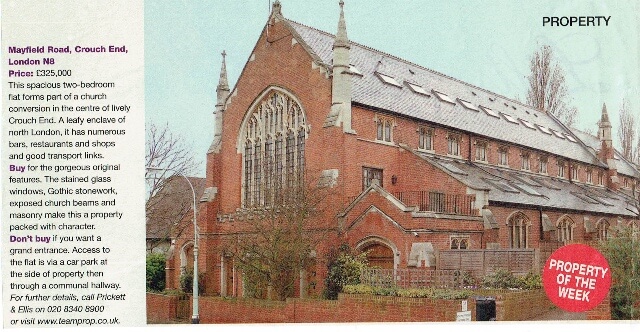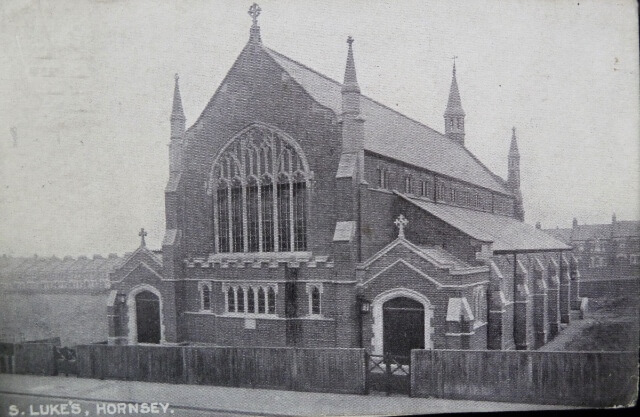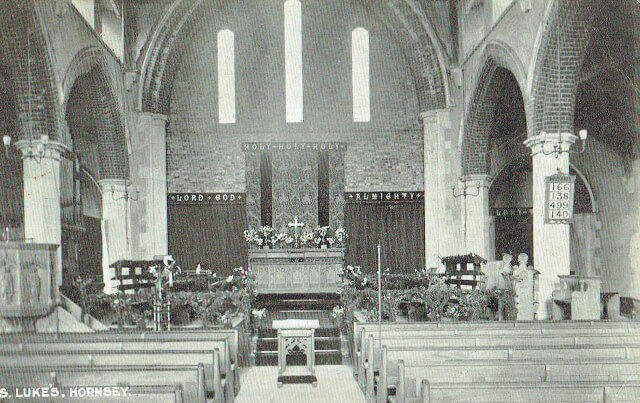This is the third article in our 2022 series on Church buildings which have changed their function.
Seeking your dream apartment in North London, modern but with a quirky difference? You may well be attracted to this apartment building by the estate agents’ photographs of the interiors and blurb about a much-favoured residential area, within easy walking distance of Crouch End’s historic Broadway, next to the green and open Stationers Park and a short bus ride to the Underground and a British Rail station. Why then does the building look exactly like a church?

How it all started
As the population of Hornsey rose rapidly in the late 19th/early 20th centuries, not only was there a demand for terraces of middle class housing but churches for the God-fearing population. The Church of England had a one-model fits all approach. The London Diocesan Home Mission was established in 1898 to plan hundreds of new parishes, and erect churches as quickly as possible. This was often with a temporary ‘tin tabernacle’ erected first. Rev. Brooke Lunn, vicar of St Luke’s Church 1968-1980, loved his parish but wrote this of the church building in HHS Bulletin 56 (2015), ‘poorly sited, architecturally nondescript and the most lowly esteemed by the Diocese of London of all the churches in Hornsey’.

The building takes shape
The new parish was carved out of three existing parishes – Christ Church, Crouch End, Holy Trinity, Stroud Green and Holy Innocents, Hornsey. A temporary iron church was built in 1898-9 and replaced by a permanent one, designed by JEK and JP Cutts, in 1903. This was the same year as the completion of the Presbyterian Church in Muswell Hill Broadway. Dedicated to St Luke, one of the four Gospel writers, it was built of red brick with stone dressings with a south west entrance, chancel, five naves, a chapel, baptistry and an organ-chamber.
Difficulties emerge
As Rev Brooke Lunn went on to say in his Bulletin article, ‘Churches were built on the basis of population size. Any available site would do’. St Luke’s Church, seating 750 worshippers, was erected with little thought given to how many Anglicans lived close by. On one Sunday in 1903, the year it opened, records show that 359 people attended in the morning and 326 in the evening. This was hardly a justification for the size of building erected. Closure was first threatened as early as 1929. Rev. Brooke Lunn was appointed to St Luke by Graham Leonard, Bishop of Willesden, in 1968. The Diocese of London authorities were not pleased. They wanted the church closed as did some parishioners. A rocky start for him indeed.

Where does viability lie?
Rev Brooke Lunn was very happy in his parish. He remembered the church, ‘full of light with a lively and cheerful congregation. It functioned well for parish worship, its primary function … and it was loved by the people’. Particularly flourishing were the Scouts, Guides and Cubs packs, all meeting in the church hall with regular Church Parades.
The vicar and congregation knew that the church was not viable in the long term and it became clear that the future lay in uniting with Stroud Green Parish and Holy Trinity Church. This happened in 1980 with Brooke Lunn becoming vicar of the united parishes. The irony was that Holy Trinity Church had been demolished in 1960 after war damage and the St Luke’s congregation left their church for a church hall. Even so, vicar and congregation settled down well, and there may possibly be a few of the St Luke’s congregation in Holy Trinity Church to this day.
Happy ever after
The church’s conversion to apartments in 1980 did not result in a tsunami of protests as happened over the Presbyterian church in Muswell Hill. For the last 40 years+ buyers have readily fallen for the unique charms of the former St Luke’s Church. Currently, a two bedroom apartment can set you back half a million pounds.